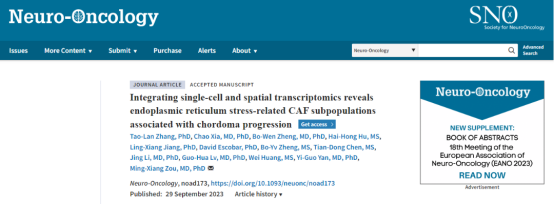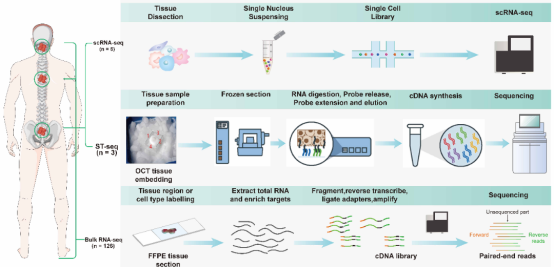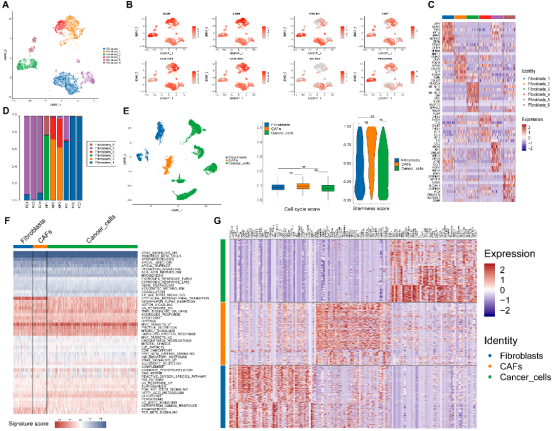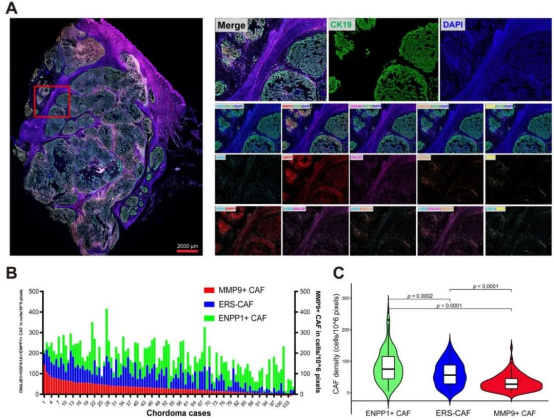On September 29, 2023, the latest original research paper from the multidisciplinary, organized scientific research collaboration of young doctoral research teams at the First Affiliated Hospital ofUniversity of South China, titled “Integrating single-cellspatial transcriptomics reveals endoplasmic reticulum stress-related CAF subpopulations associated with chordoma progression”, was published online in the international high-level journalNeuro-Oncology (a top journal in the Q1, CAS, IF=15.9). Dr. Zhang Taolan, Dr. Xia Chao,Dr. Zheng Bowen are the co-first authors of this paper. Hu Haihong, a masters student in the class of 2021 from the School of Pharmaceutical Science of University of South China,relevant researchers from the Indiana University School of Medicine (USA), the University of Toledo Medical Center (USA), Peking University, Central South University, Zhengzhou University,other institutions also participated in this study. Prof. Yan YiguoAssociate Prof. Zou Mingxiang are the co-corresponding authors, with the First Affiliated Hospital of University of South China serving as the first authorscorresponding authors affiliation.

Chordoma is a rare locally invasive malignant mesenchymal tumor, considered to originate from the remnants of the primitive notochord. It is insensitive to traditional chemotherapy,the current optimal treatment is initial maximal surgical resection with adjuvant radiotherapy. However, due to the infiltrative nature of chordomaits proximity to critical neurovascular structures, radical resection of the tumor is challenging. Many patients experience local tumor recurrenceeven metastasis after surgery, leading to adverse prognosis. Therefore, it is highly necessaryurgent to use the latest multi-omics research techniques to reveal its new molecular biological characteristicsdevelop more effective treatment methods.
Cancer-associated fibroblasts (CAFs) are the major cell type constituting the stromal compartment. Some studies have shown that, unlike normal fibroblasts, the density of CAFs is positively correlated with the invasion, metastasis,poor prognosis of many malignant tumors. While many studies have begun to reveal the molecular mechanisms of chordoma, the impact of CAFs on the development of chordoma has been rarely studied. Currently, single-cell RNA sequencing (scRNA-seq) has been widely used to explore the complex characteristics of different cell typesthe tumor microenvironment in cancer. Spatial transcriptomics (ST) sequencing can analyze cell typesgene expression changes at the structuralspatial levels. The combined sequencing of scRNAST has the advantage of accurately annotating specific cell subsetsrevealing their spatial characteristics. This study comprehensively investigated CAFs in the chordoma microenvironment using methods such as transcriptome sequencingmultiplex quantitative immunofluorescence (QIF), aiming to analyze their heterogeneity, spatial distribution,clinical significance. The study found that CAFs in the chordoma microenvironment can be dividedat least three major categories, among which the ERS-CAF (endoplasmic reticulum stress-related CAF) subset may promote the progression of chordoma through direct communication with tumor cells. This research finding will contribute to the development of new treatment methods for chordoma.

Overview of the research process related to this study


Representative research results of this study
(This study was funded by the National Natural Science Foundation of China, the Natural Science Foundation of Hunan Province, the Huxiang Young Talent Program, the Outstanding Youth Project of the Hunan Provincial Department of Education, the China Scholarship Council, the 4310 Research Project of the University of South China, the Hengyang ScienceTechnology Innovation Plan,among other funding sources.
Link to original article:https://academic.oup.com/neuro-oncology/advance-article-abstract/doi/10.1093/neuonc/noad173/7286280?redirectedFrom=fulltext)

